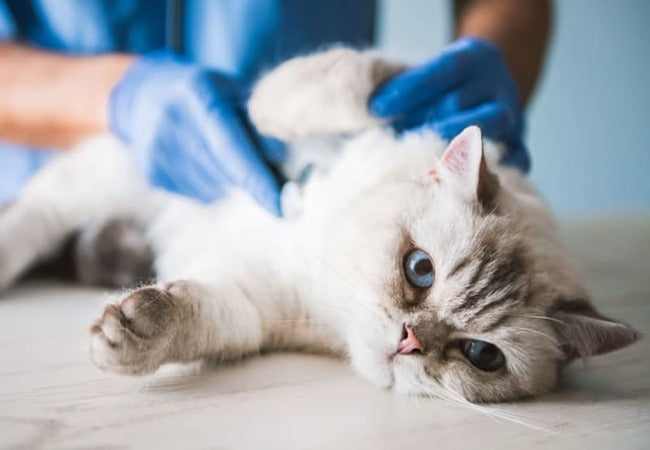Vet‑Approved 2025 Guide: Caring for Your Cat After Intestinal Blockage Surgery – Home Recovery Tips 💉🐱🩺

In this article
Vet‑Approved 2025 Guide: Caring for Your Cat After Intestinal Blockage Surgery – Home Recovery Tips 💉🐱🩺
By Dr. Duncan Houston BVSc
When your cat undergoes surgery to remove an intestinal blockage—whether from foreign objects, linear blockages, or tumors—careful aftercare is vital to ensure healing and prevent complications. This 2025 vet‑approved guide, authored by Dr. Duncan Houston BVSc, shows you exactly how to manage medications, nutrition, incision care, warning signs, and recovery support with tools like Ask A Vet. Let’s help your cat bounce back confidently and comfortably. 🐾✨
🔍 What Is an Intestinal Blockage?
An intestinal blockage happens when something—like string, toys, or a tumor—gets stuck in your cat’s digestive tract, preventing food and fluids from passing. Types include:
- Complete: Total blockage with vomiting, lethargy, no appetite.
- Partial: Some mobility; symptoms may be mild or inconsistent.
- Linear: Items like string can bunch intestines and cause tearing.
Surgery—via endoscopy or laparotomy—is often needed for removal.
🏥 Hospital Stay & Immediate Care
Post-op, your cat may stay hospitalized for 1–7 days, depending on surgery complexity. Care includes:
- IV fluids to stay hydrated
- Pain relief and anti-nausea meds
- Antibiotics to prevent infection
- Feeding tubes or bland diets while healing
- Transfusion or critical care for severe or septic cases
🏠 Bringing Your Cat Home: Setup & Comfort
- Confined space: Use a quiet room or a large crate to prevent jumping or overstretching.
- Soft bedding: Non-slip blankets or towel linings reduce strain.
- Food & water access: Shallow dishes or elevated plates help cats with E‑collars.
- Litter box setup: Use low-entry trays to avoid jumping.
🍽️ Feeding & Hydration Guidelines
Diet management is key:
- First 24–48 hrs: small quantities of bland, canned food or tube-fed nutrition
- Days 3–7: gradually increase intake; hydrate food for easy digestion
- 10–14 days: move back to regular diet as tolerated
- Monitor water intake—if staying hydrated through food, bowls can wait a day
💊 Medications & Pain Management
Follow vet instructions exactly:
- Pain meds (NSAIDs or opioids)
- Anti-nausea and stool softeners
- Antibiotics to prevent peritonitis
- If a feeding tube is used, follow care guidelines and tube site checks
🔍 Incision Care & Monitoring
- Check the incision daily for redness, swelling, discharge, or opening.
- Keep the incision area clean, dry, and protected with a suited bodysuit or E‑collar.
- Call your vet if you detect heat, pus, bleeding, or if the incision reopens.
📅 Activity & Rest Restrictions
- Limit movement, no jumping/stairs for 10–14 days.
- Short bathroom trips on a leash if the confined space is large.
- Gradual reintroduction of play only after vet approval.
⚠️ Warning Signs to Watch
- Vomiting or diarrhea after 24 hrs
- Refusal to eat or drink for 24 hrs)
- Abdominal swelling, lethargy, pale/cherry gums
- Fever, dehydration, and incision issues.
🛠️ Comfort & Support Tools
- Ask A Vet: Photo-based consults and recovery guidance without clinic stress.
📅 Expected Recovery Timeline
- Days 1–3: She’ll likely be groggy, with small soft meals. Monitor hydration closely.
- Days 4–7: Appetite improves; water consumption increases.
- Days 7–14: Incision should be healed or improving; begin gentle activity.
- Weeks 2–4: Return to normal meals and gradual activity—vet may clear when safe.
📞 When to Contact the Vet
- Severe vomiting, diarrhea, no eating/drinking
- Signs of peritonitis: fever, pain, vocalizing
- Incision leaking or painful
- Lethargy, collapse, or difficulty breathing
🏁 Final Thoughts
Recovery from intestinal blockage surgery requires careful nutrition, diligent incision care, pain management, and calm activity restriction. With vet-backed support tools like Ask A Vet, you can guide your cat through a healing and peaceful recovery. Follow the care guidelines and reach out quickly if anything seems off—here’s to your cat’s healthier future! 🐱❤️


